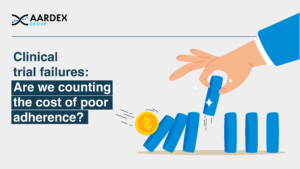“Objective and granular” digital adherence measures could improve trial efficiency and allow for better-informed decisions on the efficacy and safety of new drug products.
That’s according to the authors of a literature review that looked at more than 100 medicines approved by the European Medicines Agency (EMA) between 2010 and 2020. They found that while the majority of studies were still using the discredited pill count method, a number are now utilizing the power of digital adherence monitoring.1
Despite only having emerged in the last two decades, the digital approach was used in 2.7% of the trials overall and 12.5% of those in infectious diseases1 where optimal adherence is of paramount importance to public health.
All in all, the data signals the start of an industry-wide shift towards the digital adherence future.
Clinical, Economic, and Regulatory Consequences
For pharmacologic interventions to be effective, people must take medications as directed. But while there is a widespread assumption that clinical trial participants adhere to the study protocol, this often isn’t the case.
“Generally, medication adherence is thought to be higher in clinical trials (than in clinical practice),” wrote the authors of Medication Adherence Measurement Methods in Registration Trials Supporting the Approval of New Medicines: A Cross-Sectional Analysis of Centralized Procedures in the European Union 2010–2020.1
Reasons cited often include the specific patient selection, which tends to set strict inclusion criteria and exclude non-adherent patients during run-in phases. The extra attention the participants receive, in that they are monitored more closely over a higher frequency of clinic visits than in routine practice, is also mentioned.
“However, even strictly regulated clinical trials medication adherence can be suboptimal, resulting in both clinical and economic consequences, such as failure to show efficacy and less efficient and more costly trials,” said the paper by Mantila et al. and published in Clinical Pharmacology and Therapeutics.1
Up to 50% of people who participate in clinical trials do not take the investigational product as directed,2 and such protocol deviations can have negative regulatory consequences.
“For a medicine to be registered and to attain marketing authorization, safety, and efficacy must be demonstrated by the Marketing Authorization Holder in clinical registration studies. Inadequate assessment of adherence in these confirmatory registration trials can lead to multiple issues, such as inaccurate estimates of the efficacy, safety, and the benefit/risk balance of a medicine.1
“Failure to measure adherence properly could potentially lead to higher sample sizes for studies, unnecessarily high dosages and therefore more adverse effects, underestimation, or failure to confirm the efficacy of the medicine, and even emergence of drug resistance regarding antimicrobials.”1
Adherence Baselines
Across the life sciences sector, there is a growing awareness that adherence matters in clinical trials.
Current International Council for Harmonization of Technical Requirements for Pharmaceuticals for Human Use guidelines, for example, stipulate that adherence should be “evaluated, specified, and documented in clinical trials” and accounted for in the analysis.3,4,5 In addition, the recently developed ESPACOMP Medication Adherence Reporting Guideline (EMERGE) recommends standard reporting approaches across all studies.2
However, the extent to which medicine-taking behavior is currently recorded in clinical research is not fully understood. Mantila et al. set out to close this knowledge gap with a cross-sectional analysis of EMA marketing authorization dossiers for medicines approved in the European Union between 2010 and 2020.1
253 clinical trials of 102 medicines across diabetes, respiratory conditions, cardiovascular diseases, infectious diseases, and oncology were evaluated.1
These therapy areas were selected, the authors explained, because they represent areas with specific challenges for adherence: no direct patient notable effect (diabetes), complex inhaled administration route (respiratory), often used in polypharmacy regimens (cardiovascular diseases), public health consequences due to disease spreading and risk of resistance (infectious diseases), and severe adverse effects (oncology).1
They found that the most frequently deployed adherence measurement was pill/dose count, which was used as a single method in 52.7% of the studies and in combination with another approach in 37.7%. Patient diary or self-report was used as a single method in 6.4% of trials.1
This is important because a common failure point across these methods is that they are inaccurate and unreliable. Unlike electronic methods, which were deployed in 2.7% of the studies,1 they provide only a snapshot of medicine-taking behavior during a trial.
It has been well-documented, for example, that pill count, the most used measure, can lead to overestimations of adherence and that self-report is subjective and open to bias.
“Pill count cannot verify that a patient actually took the medicine, and bioanalytical assays cannot determine if a patient has taken the medicine only just before the trial visit, a phenomenon known as ‘white coat adherence,’ or continuously,” said Mantila et al.1
“The frequent use of pill counts is a legacy from the drug accountability process, but it is no accurate method. Pill count has higher accuracy than even more subjective measures (i.e., patient self-report), yet it only provides an average proxy measure for intake between trial visits.”1
It does not, the authors go on, “create a granular medication-taking pattern, like more objective measures such as electronic methods do”.1
Digital Adherence Monitoring
The paper highlighted therapy area-specific differences in the data, showing that 12.5% of the anti-infective trials used digital adherence monitoring.1
The method of choice was the MEMS® (Medication Event Monitoring System) cap, a smart pill bottle that automatically captures dosing events as a time and date stamp when the container is opened.
“The efficacy of treatments for infectious diseases is highly dependent on medication adherence and, moreover, nonadherence can cause resistance to the antibiotics. This can explain why electronic methods were more used in this area.”1
Applying this approach to other therapeutic areas, then, could give sponsors the information they need to make decisions vital to regulatory readiness.
“Electronic measures are a much more accurate way to capture and measure adherence than pill count, as it records time and date of each time a bottle was opened and closed, creating dosing histories,” said Matila et al.1
Electronic monitoring methods, they went on, provide a “reliable and validated drug-dosing history,” and studies have shown MEMS to have accuracy is 97%. That compares to 60% for pill count, 50% for healthcare professional rating, and just 27% for self-report.6
“With more objective and granular adherence measures in place, patients showing suboptimal adherence, i.e., it being it too poor or too high, could be more easily identified and accounted for in analyses and/or interpretation of overall results,” said Mantila et al.
It could, they concluded, help improve trial efficiency and allow for better-informed decisions on the efficacy/safety balance of new medicines – all of which will make for shorter development timelines and increased return on investment for sponsors.
References
- Mantila, K. M., Pasmooij, A. M., Hallgreen, C. E., Mol, P. G., & van Boven, J. F. (2022). Medication Adherence Measurement Methods in Registration Trials Supporting the Approval of New Medicines: A Cross‐Sectional Analysis of Centralized Procedures in the European Union 2010–2020. Clinical Pharmacology & Therapeutics, 112(5), 1051-1060.
- Eliasson, L., Clifford, S., Mulick, A., Jackson, C., & Vrijens, B. (2020). How the EMERGE guideline on medication adherence can improve the quality of clinical trials. British Journal of Clinical Pharmacology, 86(4), 687-697.
- Guideline, I. H. (2015). Integrated addendum to ICH E6 (R1): guideline for good clinical practice E6 (R2). Current Step, 2, 1-60.
- Guideline, I. H. T. (1997). General considerations for clinical trials E8. In International Conference on Harmonization of Technical Requirements for Registration of Pharmaceuticals for Human Use.
- ICH Expert Working Group. (1998, February). Statistical principles for clinical trials E9. In International conference on harmonisation of technical requirements for registration of pharmaceuticals for human use.
- El Alili, M., Vrijens, B., Demonceau, J., Evers, S. M., & Hiligsmann, M. (2016). A scoping review of studies comparing the medication event monitoring system (MEMS) with alternative methods for measuring medication adherence. British journal of clinical pharmacology, 82(1), 268-279.



